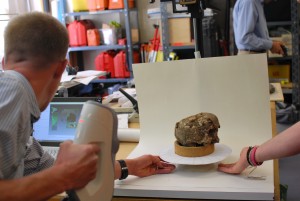
As at most sites in Devon, the soil type at Ipplepen is fairly acidic. This isn’t great for bone preservation as bones and other organic materials usually deteriorate more quickly than in less acidic soils. Whilst many of the excavated skeletons at Ipplepen are very fragile, we were very lucky to have the level of preservation we did in comparison to other Devon sites, where very little organic material remains at all. This makes the site at Ipplepen very important as it has provided an opportunity for researchers to understand more about the people who lived in Devon hundreds of years ago. Many of the skulls had to be delicately block lifted and have subsequently been carefully and skilfully excavated by Exeter students in the labs here in the archaeology department (special thanks to Enfys O’Doherty who has carried out the bulk of this work). However, they remain very fragile, only held together by the soil within them and vulnerable to further degradation.
We are very fortunate here in the University of Exeter that the College of Humanities IT team have been able to 3D scan the skulls for us so that we can create a digital model of each skull. These scans enable us to:
• Preserve a true and accurate record of the size and shape of the skull, especially key features that allow us to determine sex and age (from morphological features)
• Enable future researchers to examine and re-evaluate the skulls.
• Create a 3D print that can be handled by students in the classroom and the public at open days.